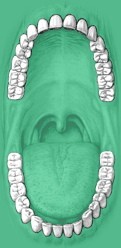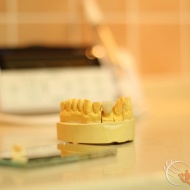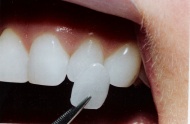
When preparing veneers the clear purpose is to satisfy your high aesthetic needs. The veneers make it possible to correct the teeth’ discoloration and their bad shape, it is suitable for eliminate the large gaps between the teeth, and for the damaged teeth’ crown part’s restoration. (The picture shows a ceramic veneer compared with contact lens.)
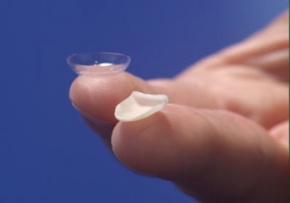
How gets on theveneer to the teeth’s surface?
The tooth preparation is required; in the course of this our doctors remove approx. half mm tooth tissue from the tooth’s outer (enamel) layer. The direct veneers the dentist, the indirect shells the dental technician (under impression) makes. It’s fixing fixing on the tooth happens with special, very strong glue. It is very beautiful, natural looking, aesthetic solution. Considering its material it can be made from ceramics, in the rear region even from synthetic resin based material.
| Before | After |
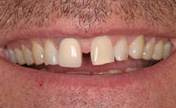 |
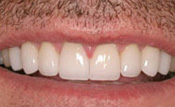 |
In which cases recommend we the veneers?
- If the front teeth discolored, become grey and the tooth whitening is ineffective (e.g. acquired tetracycline discoloration).
- If the shape of the front teeth is inadequate.
- If the congenital enamel or dentinogenesis disorder arise. (enamel-, dentinhypoplasia).
- If positional disorder arises in the front area which can’t be solved with orthodontic treatment or the patient doesn’t want to solve it.
- If there is a gap between the front teeth (diastema).
- If you are not satisfied with your smile.
- If a part broke down from the front tooth and it isn’t practical to repair it with filling.
With the preliminary smile design it can decide that into which teeth gets on the veneer. The lateral incisors, the central incisors, the canines, and even the premolar teeth’ color, shape can be changed with gluing the veneers.
Types of veneers:
- Direct Veneers
- Indirect Veneers
Direct veneers
A direct veneer is built up over the tooth surface by hand. It is most commonly done using tooth colored composite resin. Direct veneers are a more simple procedure, and are generally done in a single appointment. They are less expensive but do tend to deteriorate more quickly and rarely get the high level of aesthetics that indirect veneers achieve.
Indirect veneers
An indirect veneer is made in a dental laboratory and is generally constructed from porcelain. Indirect veneers usually require two appointments. The first is when the preparation and impressions are done; the second is when the veneer is fitted. They are more expensive as compared to direct veneers and their life is also more as compared to direct veneers.
Both types of veneer usually involve some reduction being made in the enamel surface of the tooth in order to create room for them.
Veneers can greatly improve the appearance of a person’s teeth, making them more uniform, changing their color and size. However they do generally require tooth preparation meaning that they are not a reversible procedure.
Composite veneers
The major advantage of composite veneers is treatment time. If composite is used, the dental veneers can be carried out in one appointment. The dentist will actually prepare the veneers directly on the prepared teeth.
The veneers will be smoothed and polished to look like your natural teeth. Since it takes only one appointment, you can leave your dentist's office with a brand new smile.
One of the disadvantages of composite veneers is that they are not as strong as porcelain veneers and therefore are more prone to fracture. However, if a fracture does occur, they can be easily repaired because the same material that was used initially to make the veneers can be added in the same manner to fix it.
Another disadvantage is the color, although it is stable, is not as stable as the same porcelain veneer restoration. This means that over time the veneers usually get darker or turn yellow. This change in color can warrant the replacement of the composite veneers.


